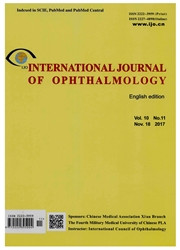

 中文摘要:
中文摘要:
AIM: To investigate the effect of CC chemokine receptor 3 (CCR3) signal on corneal neovascularization (CRNV) induced by alkali burn and to explore its mechanism. · METHODS: Specific pathogen-free male BALB/C mice (aged 6-8 weeks) were randomly divided into CCR3-antagonist treated group (experimental group) and control group. CRNV was induced by alkali burn in mice. The time kinetic CCR3 expression in injured corneas was examined by reverse transcription polymerase chain reaction (RT-PCR). CCR3- antagonist (SB-328437 at different concentration of 125μg/mL, 250μg/mL, and 500μg/mL) was locally administrated after alkali injury. The formation of CRNV was assessed by CD31 corneal whole mount staining at two weeks after injury. Monocyte chemotactic protein 1 (MCP-1), monocyte chemotactic protein 3 (MCP-3) expressions in the early phase after injury were quantified and compared by RT-PCR. Macrophage intracorneal accumulation in the early phase after injury was evaluated and compared by immunohistochemistry. · RESULTS: Alkali injury induced the time kinetic intracorneal CCR3 expression. 500μg/mL of CCR3-antagonist treatment in the early phase but not the late phase resulted in significant impaired CRNV as compared to control group(P 【0.05). CCR3-antagonist treatment in the early phase significantly reduced the intracorneal MCP-1 and MCP-3 enhancement compare to control group at day 2 and day 4 (P 【0.05). Moreover, the number of intracorneal macrophage infiltration in the experimental group was reduced than those in control group at day 4 (P 【0.05). · CONCLUSION: CCR3 signal is involved in alkali-induced CRNV. CCR3-antagonist can inhibit alkali-induced CRNV by reducing the intracorneal MCP-1 and MCP-3 mRNA expression and the intracorneal macrophage infiltration.
 英文摘要:
英文摘要:
AIM: To investigate the effect of CC chemokine receptor 3 (CCR3) signal on corneal neovascularization (CRNV) induced by alkali burn and to explore its mechanism. METHODS: Specific pathogen-free male BALB/C mice (aged 6-8 weeks) were randomly divided into CCR3-antagonist treated group (experimental group) and control group. CRNV was induced by alkali burn in mice. The time kinetic CCR3 expression in injured corneas was examined by reverse transcription polymerase chain reaction (RT-PCR). CCR3-antagonist (SB-328437 at different concentration of 125 mu g/mL, 250 mu g/mL, and 500 mu g/mL) was locally administrated after alkali injury. The formation of CRNV was assessed by CD31 corneal whole mount staining at two weeks after injury. Monocyte chemotactic protein 1 (MCP-1), monocyte chemotactic protein 3 (MCP-3) expressions in the early phase after injury were quantified and compared by RT-PCR. Macrophage intracorneal accumulation in the early phase after injury was evaluated and compared by immunohistochemistry. RESULTS: Alkali injury induced the time kinetic intracorneal CCR3 expression. 500 mu g/mL of CCR3-antagonist treatment in the early phase but not the late phase resulted in significant impaired CRNV as compared to control group (P <0.05). CCR3-antagonist treatment in the early phase significantly reduced the intracorneal MCP-1 and MCP-3 enhancement compare to control group at day 2 and day 4 (P <0.05). Moreover, the number of intracorneal macrophage infiltration in the experimental group was reduced than those in control group at day 4 (P <0.05). CONCLUSION: CCR3 signal is involved in alkali-induced CRNV. CCR3-antagonist can inhibit alkali-induced CRNV by reducing the intracorneal MCP-1 and MCP-3 mRNA expression and the intracorneal macrophage infiltration.
 同期刊论文项目
同期刊论文项目
 同项目期刊论文
同项目期刊论文
 Potential involvement of nitric oxide synthase but not inducible nitric oxide synthase in the develo
Potential involvement of nitric oxide synthase but not inducible nitric oxide synthase in the develo Critical role of SDF-1 alpha-induced progenitor cell recruitment and macrophage VEGF production in t
Critical role of SDF-1 alpha-induced progenitor cell recruitment and macrophage VEGF production in t 期刊信息
期刊信息
